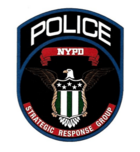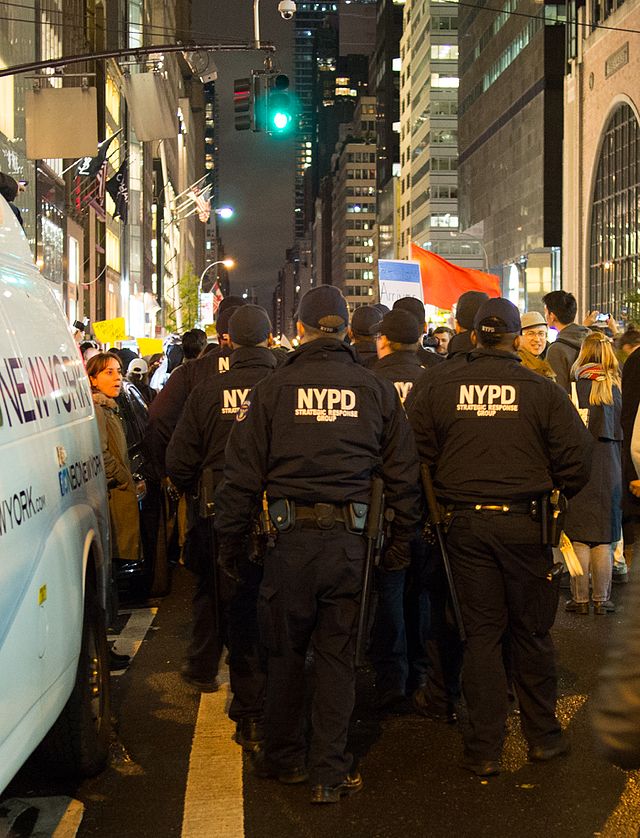New York City Police Department Strategic Response Group
Police unit in New York City From Wikipedia, the free encyclopedia
The New York Police Department's Strategic Response Group (SRG) is a unit of the New York City Police Department (NYPD) formed in 2015 to police protests. It was announced in 2014 by NYPD Police Commissioner William J. Bratton as a unit that would also be dedicated to counterterrorism until it was separated following controversy. The unit has been criticized for its use of excessive force and mass arrests against political demonstrators protected under the First Amendment, disproportionately high numbers of complaints to the Civilian Complaint Review Board, among other issues. Activists, the New York City Council, the New York City Department of Investigation, and organizations such as Human Rights Watch and the New York Civil Liberties Union, among others, have called for its regulation or disbandment.
| Strategic Response Group | |
|---|---|
 Badge of the SRG | |
| Active | 2015–present |
| Country | United States |
| Agency | New York City Police Department |
| Role |
|
| Part of | Special Operations Bureau |
| Common name | The "Goon Squad" |
| Abbreviation | SRG |
| Structure | |
| Officers | Approx. 800 |
| Squads | |
| Commanders | |
| Current commander | Deputy Chief John D’Adamo[2] |
| Website | |
| www1 | |

History
Summarize
Perspective
2014–2019


In January 2014, NYPD Police Commissioner William J. Bratton announced plans to create the SRG, a 300-350 officer unit equipped with machine guns, long guns, and heavy protective gear dedicated to policing protests and counter-terrorism. [3][4] Bratton also announced the SRG would be partially funded by the Department of Homeland Security.[5] After public backlash, Chief of Department James O'Neill stated the SRG would not be involved in handling political demonstrations.[3][4] Bratton then announced approximately 300 officers dedicated to counter-terrorism would augment the NYPD Emergency Service Unit while the "Strategic Response Group" would refer to approximately 500 officers dedicated to handling protests as well as reinforcing precincts in need of back-up.[6][7] He stated that they would no longer be equipped with machine guns,[5] though the SRG were still trained to use and outfitted with semiautomatic rifles.[8]
In March 2015, the NY chapter of the National Lawyers Guild released a statement saying "the plain intent of [SRG] is to suffocate political dissent".[5] In September, Deputy Inspector Andrew J. Lombardo, a prominent officer involved in policing protests in NYC who had been frequently accused of targeting and interrogating protestors, was assigned to the SRG as a "supervisor".[5][9]
By the end of 2015, the SRG had been deployed to suppress multiple Black Lives Matter protests, sometimes using military grade Long-range acoustic devices (LRAD) and aggressively arresting demonstrators and members of the press. The SRG also increased in size to approximately 800 officers.[10] The New York Civil Liberties Union (NYCLU) stated it would keep watch on the SRG.[11] The Verge obtained NYPD documents showing police camera teams were deployed to hundreds of BLM and Occupy Wall Street protests. Lombardo requested NYPD videos of "mass arrests" at a December 4, 2014 BLM protest despite not being a member of the NYPD Legal Bureau.[9] The SRG gained a reputation among activists in the city as the "goon squad".[10][12][1][13][14]
In December 2017, the SRG initiated a no-knock raid wherein an officer shot and killed Mario Sanabria, a 69-year-old resident, who they claimed had attacked them with a sword.[15] Sanabria's family and roommate have insisted he didn't and that the NYPD had acted on a bad tip from a confidential informant.[16]
In January 2018, the SRG cleared people protesting the deportation of Ravidath Ragbir by Immigrations and Customs Enforcement (ICE). Ragbir is an immigrant rights activist and head of the New Sanctuary Coalition, an organization that legally aids immigrants seeking asylum.[17] The SRG violently arrested 18 protestors during the event. New York City Council members held an oversight hearing questioning NYPD officials about the incident. NYPD refused to comment on the unit's involvement.[18] One officer was transferred out of the unit and stripped of 30 vacation days after a departmental investigation found him guilty of "using excessive force to clear a crowd of protestors". He had been caught on video throttling at least two protestors.[19][20]
In October, the SRG was assigned to a protest at the Metropolitan Republican Club, which had invited Gavin McInnes - the founder of the Proud Boys - to speak. McInnes re-enacted the assassination of Japanese socialist Inejiro Asanuma. Video from the protest showed a group of uniformed proud boys beating protestors as the SRG watched. A police spokesperson said there was no open investigation into the Proud Boys' conduct. Three anti-fascist protestors were arrested and the Republican Club publicly thanked the NYPD.[16][21][22] The Republican Club defended its decision to welcome McInnes; McInnes thanked and defended the NYPD in a podcast a few days later.[22] One Proud Boy was later arrested for the assault.[16]
2020–present
In June 2020, about 300 demonstrators protesting police violence and systemic racism in Mott Haven were kettled by the SRG.[23] In September, Human Rights Watch (HRW) released a report about the incident which found over 100 protestors were injured. HRW described the NYPD's conduct as "serious violations of international human rights law" and the First Amendment.[1][23] [24] The report also found at least 13 legal observer were detained, sometimes violently. 263 people were arrested, a higher figure than any other protest since the killing of George Floyd. NYPD commissioner Dermot Shea confirmed the arrests were premeditated and said the protest was caused by "outside agitators" to "cause mayhem" and "injure cops". HRW found the protest was peaceful until the violent response of the NYPD.[24]
In October, The Appeal analyzed footage of protests in June and September and identified 62 SRG officers. The officers had a total of 292 misconduct allegations; on average, each officer had 2 complaints filed against them with the Civilian Complaint Review Board (only 40% of all NYPD personnel had 2 or more incidents filed). 14 supervisors had multiple conduct misconduct allegations. SRG 4, the Bronx unit, had the most officers with misconduct allegations.[1] In December, the New York City Department of Investigation released a report which found the NYPD had used "excessive enforcement" against protestors, suppressed lawful First Amendment assembly, and called for reducing the role of the SRG.[25][26] The report stated the SRG's tactics "may have unnecessarily provoked confrontations between police and protesters, rather than de-escalating tensions".[27]
According to a report prepared by the City Council Finance Division in March 2021, the SRG led all units in overtime expenditures.[28] In September, the NYCLU launched a campaign to disband the SRG.[29][30]
In May 2022, a City Council Public Safety Executive Budget hearing questioned the NYPD's role in sweeping homeless encampments, particularly the SRG's constant presence in the sweeps.[31] In August, a report by the NYCLU criticized the NYPD, noting that the perpetrator of the 2022 New York City Subway attack had been blocks away from dozens of officers, including the SRG, who had been deployed sweeping a homeless encampment and destroying the belongings of unhoused New Yorkers rather than searching for the shooter.[32]
In October, elected officials, civil rights groups, and grassroots organizers staged a rally at City Hall Park calling for the abolishment of the SRG. Council members championed a bill that would prevent the NYPD from using the SRG to break up nonviolent protests. Members of NYC for Abortion Rights were also present, saying that the SRG provided escorts for anti-choice protests but manhandled those protecting Planned Parenthood clinics.[33] People also protested in January 2023, when the City Council's Public Safety Committee postponed a hearing on the SRG for the second time, despite over 100 members of the public signing up to speak. Officials said the delay was due to the number of lawsuits pending against the NYPD for its response to the BLM protests of 2020.[29]
On March 1, 2023, the City Council held its first oversight hearing on the SRG. Over 100 individuals testified alleging SRG violence. The NYPD did not attend and submitted written testimony instead; the council criticized the NYPD's decision not to attend. The city agreed to pay $4–6 million to the approximately 300 demonstrators penned by police during the Mott Haven protest.[34][35]
Operations
Summarize
Perspective
The SRG is composed of five borough-based teams and the Disorder Control Unit (DCU). The DCU predates the SRG and is known for engaging in mass arrests, military-style tactics, and their role in policing Occupy Wall Street, the 2003 anti-war demonstration, and the 2004 Republican National Convention.[1][13][36] It operates under the NYPD's Special Operations Bureau.[33]
In October 2015, the NYPD announced the "Citywide Anti-Crime Team", an offshoot of the SRG that they said would have the sole purpose of ridding the streets of guns.[37]
Initially composed of about 300 officers with a budget of $13 million, within a few years the officer count had doubled and the budget had grown to $90 million.[38] The SRG is equipped with anti-riot gear, a fleet of bicycles with armored riders, and heavy weaponry. The SRG is a voluntary unit that attracts cops looking for "more action".[38] A spokesperson for the NYPD stated SRG training includes a specialized SRG academy, an annual two-day course, and 8 monthly 2-hour surprise drills. SRG's Bicycle Squad members participate in an annual two-day refresher course.[38]
The SRG has advanced notice of protests and monitors social media for intelligence. When a detail is approved, a field officer compiles information on group size, key members, group hierarchy, and planned arrests to send to executive staff and the commanding officer.[38] At protests, SRG officers are instructed to report to the local commander and not exercise discretion except for felonies and serious misdemeanors. Mass arrests are under the purview of department leadership.[38] SRG documents define protestors as either "peaceful" or "violent", with examples of the latter including the "BLM movement, Occupy Wall Street, and Anti-Trump Demonstrators".[39] Tactics used by the SRG at protests include "wedge formation", to separate a crowd in half, "separation formation", to divide protestors and counter-protestors, and "encirclement formation", a tactic more commonly known as "kettling", in which officers surround a crowd providing no means of escape.[38]
References
Wikiwand - on
Seamless Wikipedia browsing. On steroids.
